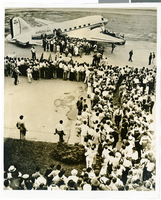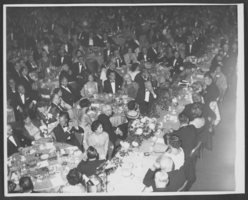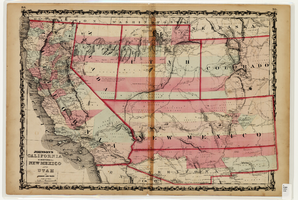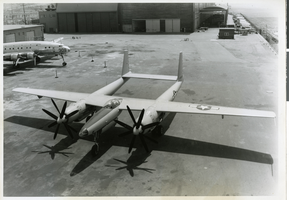Search the Special Collections and Archives Portal
Search Results
Harbor reports - New York City map, 1925
Level of Description
File
Archival Collection
Union Pacific Railroad Collection
To request this item in person:
Collection Number: MS-00397
Collection Name: Union Pacific Railroad Collection
Box/Folder: Box 53
Collection Name: Union Pacific Railroad Collection
Box/Folder: Box 53
Archival Component
New York Mine, Silver City, Nevada, undated
Level of Description
File
Archival Collection
Mary Griffith Toleno Photograph Collection
To request this item in person:
Collection Number: PH-00021
Collection Name: Mary Griffith Toleno Photograph Collection
Box/Folder: Folder 01
Collection Name: Mary Griffith Toleno Photograph Collection
Box/Folder: Folder 01
Archival Component
New York Mine, Silver City, Nevada, undated
Level of Description
File
Archival Collection
Mary Griffith Toleno Photograph Collection
To request this item in person:
Collection Number: PH-00021
Collection Name: Mary Griffith Toleno Photograph Collection
Box/Folder: Folder 01
Collection Name: Mary Griffith Toleno Photograph Collection
Box/Folder: Folder 01
Archival Component
New York Mine, Silver City, Nevada, undated
Level of Description
File
Archival Collection
Mary Griffith Toleno Photograph Collection
To request this item in person:
Collection Number: PH-00021
Collection Name: Mary Griffith Toleno Photograph Collection
Box/Folder: Folder 01
Collection Name: Mary Griffith Toleno Photograph Collection
Box/Folder: Folder 01
Archival Component
New York Mine, Silver City, Nevada, undated
Level of Description
File
Archival Collection
Mary Griffith Toleno Photograph Collection
To request this item in person:
Collection Number: PH-00021
Collection Name: Mary Griffith Toleno Photograph Collection
Box/Folder: Folder 01
Collection Name: Mary Griffith Toleno Photograph Collection
Box/Folder: Folder 01
Archival Component

Photograph of a crowd watching Howard Hughes boarding an airliner, circa July 1938
Date
1938-07-15
Archival Collection
Description
Crowd of people watching Howard Hughes board an airliner that was heading for Washington.
Image

Photograph of a formal dinner at the Hotel Astor, New York City, 1958
Date
1958
Archival Collection
Description
A Formal dinner at the Hotel Astor in New York City, 1958. Wilbur Clark is located at the center of the picture, leaning his elbow on the table to the right. (Credit: Bill Mark, Park Sheraton Hotel, NYC.)
Image

Map of California and Territories of New Mexico and Utah, 1862
Date
1862
Description
Scale [ca. 1:3,231,360. 1 in. to approx. 51 miles] (W 125°00--W 103°30/N 42°00--N 31°45) ; 1 map : hand col. ; 40 x 60 cm., on sheet 46 x 68 cm ; Relief indicated by hachures and spot heights ; Prime meridians: Greenwich and Washington, D.C ; Decorative border ; Hand colored ; Atlas p. numbers in upper margin: 58-59 ; Date est. from territorial borders and county configuration ; Shows natural features, locations of Indian tribes, proposed railroad routes, routes of explorers, trails, county boundaries and populated places ; Johnson and Ward
Image
Harrah's Grand, Atlantic City, New Jersey, 2001
Level of Description
File
Archival Collection
Robert Beckmann Photographs
To request this item in person:
Collection Number: PH-00381
Collection Name: Robert Beckmann Photographs
Box/Folder: Box 02
Collection Name: Robert Beckmann Photographs
Box/Folder: Box 02
Archival Component

Photograph of the XF-11 prior to its first test flight in Culver City, California July 7, 1947
Date
1947
Archival Collection
Description
Transcribed from press release attached to back of photo: "NEW-DESIGN PHOTO PLANE COMPLETED CULVER CITY, Calif., July 7 -- test-flown today for the first time, the new XF-11 was revealed as one of the world's fastest long-range photographic planes. It was designed and built by Howard Hughes in conjunction with the Air Materiel command engineers. Army officials said that it can attain a speed of more than 400 miles per hour and a ceiling of more than 40,000 feet. The plane has a pressurized cabin making it unnecessary for the crew to use oxygen masks. Outstanding features include a full-span flap, unique eight-camera layout and exceptionally fast take-off." Transcribed from photo sleeve: "Howard Hughes sits in the cockpit of the XF-11, a reconnaissance plane that Hughes built and designed in conjunction with Air Materiel Command engineers. Hughes is preparing for his first test flight in Culver City, California July 7, 1947."
Image
Pagination
Refine my results
Content Type
Creator or Contributor
Subject
Archival Collection
Digital Project
Resource Type
Year
Material Type
Place
Language
Records Classification
